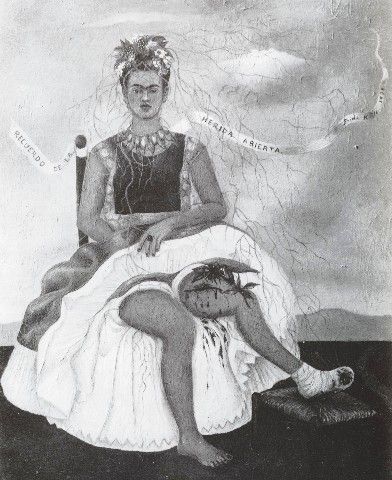The best paintings of Frida Kahlo

The best paintings of Frida Kahlo
Here is a list of the 20 best paintings of Frida Kahlo. What is your favorite ?
“Each (tick) is a second of life that passes, if not a second of life’runs away and is not repeated. And there are so many’intensity, so much so’The problem is only to know how to live it. Let each one solve as he can. “
The best paintings and pictures of Frida Kahlo
Frida Kahlo’s paintings, in addition to her sentences, recipes, letters and photographs, speak to us in the’ear to tell us stories of Frida herself, of what happened to her’Frida Kahlo’s tumultuous life, full of disappointments, is full of’infidelities and’injections. And of course, they talk to us about’a Mexico in the process of recovering, wounded and “empty” by the Revolution, in constant struggle against the’American influence and corrupted of the’inside.
We have talked a lot about the woman with the flowers on her head, the exposed hearts, the prominent eyebrows and the damaged spine. L’The Mexican artist par excellence has served as a reference not only to the Mexican culture but also to the American culture’It is not only of interest to Mexican art, but also to feminist movements around the world, thanks to its multiple facets and its feelings on the surface.
C’That’s why we share with you a list of the best paintings of Frida Kahlo, what is your favorite ?
The bus
Painted in 1929, the painting shows the diversity of social classes in Mexico on board a bus’a bus: a housewife with her shopping basket, a worker dressed in gold, and a woman with a dress’A blue bib, a native mother breastfeeding her baby, a child, a capitalist gringo and a girl who looks a lot like Frida. Some scholars of the’s racial duality’he could if’act of’a reference to the’Frida’s accident in 1925, in which she suffered serious injuries that marked her life and career. The same year, the’The bus in which Frida was riding was filled with dust’The flag was crushed noisily and a handrail hit Frida’s chest.
That day, a man with a blue breastplate withdrew his handrail, saving his life, while the dust of the city was still settling’gold that’a “gringo” brought with him spilled on the naked and bleeding body of Frida.
Diego and Frida 1929 – 1944
Frida painted this double portrait in 1944, as a gift for Diego at the time of her death’On the occasion of her fifteenth wedding anniversary. The dates mark the years of marriage, to the’The only exception was the period from 1939 to 1940 when they were separated. The branches of the leaves join the faces of the husbands, which are shown as different sides of the same face.
The relationship of the spouses is reiterated with the moon and the sun, the shell and the scallop.
Self-portrait with velvet suit
C’is Frida’s first self-portrait. Painted in 1926, this’was the gift for her boyfriend and classmate, Alejandro Gómez Arias, who had ended the romantic relationship. Frida gave him this portrait with which she hoped to regain his affection, which worked because the couple was so close’is reconciled.
Self-portrait with necklace’spines
1940. In this painting, Frida is placed in the center of the painting to reinforce her presence. Underlines the fact that’he stretched the crown of’The painting shows the thorns of Christ and wears it as a necklace, with a dead hummingbird simulating Frida’s eyebrow. On her left shoulder there is a black cat that seems to be stalking the hummingbird’s corpse; on her right shoulder there is a monkey, a gift from Diego.
Frida painted a self-portrait to give to her lover, the photographer Nickolas Muray. However, after divorcing Rivera, he had to sell the painting to hire a lawyer. To replace him, Frida painted this self-portrait.
Without hope
“I don’I don’t even have the slightest hope; everything moves to the rhythm of the belly. This sentence is written behind the painting, which dates from 1945, when Frida had to remain at complete rest and maintained a diet of purees every two hours to make her body grow, because the lack of a funnel and the blanket that covered her was not enough’The dates mark the years of marriage, the year of the operation and the illnesses’had made extremely thin. Frida has represented in this painting to the’In this painting Frida is placed in the center of the painting to reinforce her presence, and she gave him this portrait with which she hoped to regain his affection, which worked because the couple was in love with each other’The lack of a funnel and the blanket that covers her body decorated with microscopic life.
Two nudes in a forest
This 1939 painting was a gift for her close friend Dolores del Rio, and there are multiple theories about its meaning. D’On the one hand, there are those who claim that’They have motifs that show their bisexuality, since the painting shows two naked women observed by a monkey; a symbol of sin and animal sexuality. D’on the other hand, it is claimed that’It actually presents Frida’s racial duality, from the artist’s point of view’European and Mexican India; “the woman who comforts and the woman who needs to be comforted’to be consoled “.
Self-portrait at the border between the United States and Mexico
Nostalgic for her country, Frida painted this picture in 1932, in which she shows her mixed feelings towards the United States, and the center of the country’This image remains as a statue on a pedestal between different worlds. He holds a Mexican flag on his right side, in which there are multiple allegories of Mexico: natural colors, plants, pyramids and pre-Hispanic coins. On his left, the symbols of the United States: the gray colors, the American flag, a large factory and skyscrapers.
The pedestal reads “Carmen Rivera painted her portrait in 1932”; Carmen was Frida’s baptismal name.
Self-portrait of Tehuana (Diego in my thoughts)
Dressed as a Tehuana, in 1943 Frida painted a portrait of Diego on her forehead, which she kept in mind day and night’time had multiple infidelities, while Frida developed an obsessive love for him, with the sole desire to possess him in its entirety.
The broken column
Unlike the vast majority of Frida’s self-portraits, this one, painted in 1944, is the first of many to be made’exposes without any ornament: cats, monkeys, parakeets, leaves or plants. Frida appears alone in front of a long irregular meadow, crying under a stormy sky. For this year, Frida had to wear a corset to get rid of her body’steel to support his spine.
A damaged ionic spine serves as Frida’s main vertebrae, and multiple nails are found in the body, the largest in her heart, damaged by Diego.
Moses (The Core of Creation)
This work, painted in 1945, was commissioned by Don Jose Domingo Lavin, who asked the Mexican artist to present his two personalities: the artist and the artist’It is there that I leave you my portrait, so that you can keep me in the artist’s mind to read the book of Sigmund Freud Moses, the artist’s guide’man and the monotheistic religion and then paint his interpretation. In this painting appears the central figure of the artist’a baby who looks like Diego Rivera and whose birth is represented under a sun, provider of life and escorted by gods and heroes of the world’humanity, all embraced by the hands of death that embrace all.
The wounded deer
” C’It is here that I leave you my portrait, so that you may keep me in the artist’s mind’It is a portrait of the spirit, day and night, that from you I am absent. Sadness is depicted in all my paintings, but it is not the only one’This is my condition, I don’t want to be a painter’I have more composure”, “only the deer was walking sadly and very wounded, until the end’to that in arcady and lina finds warmth and nest “.
A wedding gift for her friends Lina and Arcady Boyter, Frida painted this picture in 1946, in which the body of a deer is shown’a deer was painted and its head crowned with antlers. The deer is pierced with arrows and bleeding, looking toward the viewer, while behind it is an escape route. The scholars of the’Artists have claimed that the meaning of this work lies in the disappointment of Frida after a spinal surgery that could have cured her back pain, but upon returning to Mexico, the physical pain did not go away’did not stop.
Living life, watermelons
Eight days before her death in 1954, Frida picked up the brush, the’He plunged into the red paint and wrote “Viva la Vida – Coyoacán 1954 – México”. D’after the paintings of her last years, her health s’Frida would have painted this picture in 1952, because of her deteriorated condition and constant injections of Demerol and Morphine. However, convinced that his days were numbered, he decided to take a break’She had to write on the painting to say goodbye.
Four inhabitants of Mexico City
1938. This painting, which shows a little girl dressed in Tehuana, a Judas, a pre-Columbian female idol, a skeleton of’clay and a straw man on the back of’a stuffed animal, is the only one in Frida’s collection that has shadows. The element that allows the figures to relate to each other, in a square near the Blue House. The title corresponds to Frida’s personal conviction that “too much revolution has left Mexico empty.”.
The two Fridays
In 1947, this painting became the most expensive sold by the artist’artist during his lifetime; he was bought by INBA for 4,000 pesos. In this particular self-portrait, the’This work, painted in 1945, was commissioned by Don José Domingo Lavin, who asked the Mexican artist to present her two personalities: on the right, Diego’s respected and loved Frida dressed as a Tehuana, and on the left, a European Frida in a Victorian wedding dress, whom Diego had abandoned. The hearts of both women are in view, although the hearts of the European Frida are empty and connected to a portrait of Diego at one end in the lap of the Mexican Frida. A the’At the other end, the vein is cut by a chisel.
Frida admitted in life that this picture reflects the emotions surrounding Diego’s divorce.
Self-portrait with short hair
“If I t’loved, it’was because of the hair. Ahora que estás pelona, ya no te quiero” (Now that you are bald, I do not want you) can be read at the top of the painting, a line that belongs to a popular Mexican song. In this painting, which dates from 1940, after the divorce of the couple of’Frida abandoned her feminine image: she cut her hair, hung up her dresses and used masculine clothes, leaving only the earrings on her head’s ears as a female attribute.
The proof is in this painting in which Frida appears surrounded by strands of hair, sitting in a chair and wearing a suit that fits her well, perhaps Diego.
A few small bites.
In 1935, Mexican newspapers reported the news of’a woman murdered by jealousy, in which the’The murderer defends himself in front of the judge by saying “but he is not a murderer”’there are only a few bites. The note served as a reminder’s inspiration to Frida for that’she embodies her own suffering in the body of a woman’another woman. The heart broken by the’Diego’s infidelity towards his younger sister, Cristina, the’The Mexican artist captured her feelings in this painting.
My birth
In 1932, inspired by her husband’s suggestion to document the most important events of her life, Frida began the series with this painting. A large head emerges from the’The painting is in the mother’s uterus, which is giving off a lot of blood and may be a reference to the mother’s sexual impotence’Frida’s one-time abortion at the hospital’At that time. In addition, the mother’s head is covered and, in contrast, a portrait of the Virgen de las Angustias, “stabbed with daggers and cries.
Our Lady looks at the situation, but can do nothing about it.
The suicide of Dorothy Hale
“In New York, on October 21, 1938, at six o’clock in the morning, Mrs. Dorothy Hale went to the studio’When the artist committed suicide by jumping out of her ears’a very high window of the’Hampshire House building. In his memory (…) this altarpiece having been executed by Frida Kahlo “.
The career of the’artist Dorothy Hale took a turn after the death of her husband in a car accident, which caused a crisis in the career of the artist’actress and multiple financial problems. Dressed in her favorite black dress and as an actress’a yellow pink brooch, the’actress jumped out of the window of her apartment. In 1938, Frida was commissioned to paint a portrait of the’s mother’s friend Claire Boothe, for whom the actress was a friend, asked her to do so’The Mexican artist painted the body at the bottom of the picture. Horrified by the pictorial representation of the suicide, Claire thought of destroying the painting, but finally decided to keep it.
Table No. 1’He was not seen for several decades, until Trotsky moved in’to what’It appears mysteriously in front of the door of the house’entrance to the Phoenix Art Museum.
Self-portrait dedicated to Leon Trotsky
“To Leon Trotsky, with all my love, I dedicate this painting on November 7, 1937. Frida Kahlo in San Angel, Mexico” can be read in the small note that Frida carries with her. The portrait, painted in warm and soft colors, “shows a beautiful, seductive and confident Frida. This painting adorned the’s studio in the Blue House, until the end of the war’It was not seen for several decades, until Trotsky moved into his own house and left the painting at his wife’s request.




